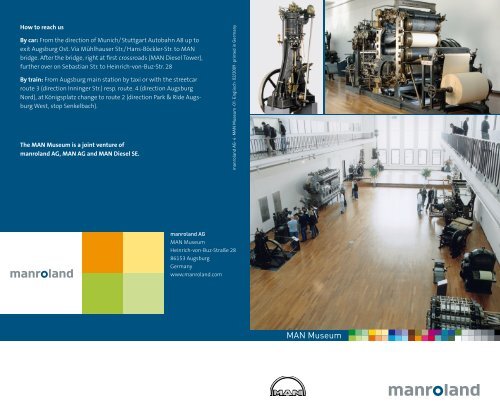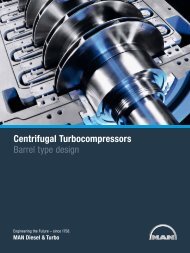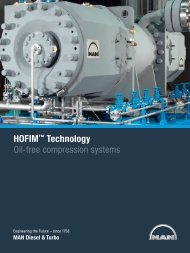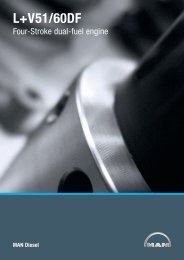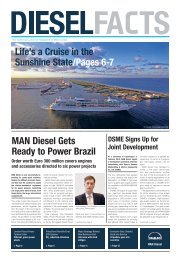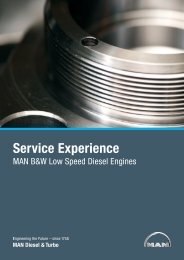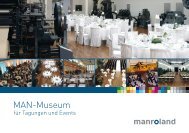MAN Museum - MAN Diesel & Turbo - 首页
MAN Museum - MAN Diesel & Turbo - 首页
MAN Museum - MAN Diesel & Turbo - 首页
Create successful ePaper yourself
Turn your PDF publications into a flip-book with our unique Google optimized e-Paper software.
How to reach us<br />
By car: From the direction of Munich/ Stuttgart Autobahn A8 up to<br />
exit Augsburg Ost. Via Mühlhauser Str./ Hans-Böckler-Str. to <strong>MAN</strong><br />
bridge. After the bridge, right at first crossroads (<strong>MAN</strong> <strong>Diesel</strong> Tower),<br />
further over on Sebastian Str. to Heinrich-von-Buz-Str. 28<br />
By train: From Augsburg main station by taxi or with the streetcar<br />
route 3 (direction Inninger Str.) resp. route. 4 (direction Augsburg<br />
Nord), at Königsplatz change to route 2 (direction Park & Ride Augsburg<br />
West, stop Senkelbach).<br />
The <strong>MAN</strong> <strong>Museum</strong> is a joint venture of<br />
manroland AG, <strong>MAN</strong> AG and <strong>MAN</strong> <strong>Diesel</strong> SE.<br />
manroland AG<br />
manroland AG · 4 · <strong>MAN</strong> <strong>Museum</strong> · 01 · Englisch · 02/2009 · printed in Germany<br />
<strong>MAN</strong> <strong>Museum</strong><br />
Heinrich-von-Buz-Straße 28<br />
86153 Augsburg<br />
Germany<br />
www.manroland.com<br />
<strong>MAN</strong> <strong>Museum</strong>
WELCOME<br />
The <strong>Museum</strong> .................................................................................................... 4 – 5<br />
History of <strong>MAN</strong> und manroland .............................................................. 6 – 9<br />
Characters .................................................................................................... 10 – 11<br />
<strong>MAN</strong> und manroland Milestones ....................................................... 12 – 15<br />
Tour/Exhibits ............................................................................................... 16 – 26<br />
Conference Center ............................................................................................. 27<br />
Opening hours:<br />
By telephone appointment,<br />
Monday till Friday from 9 a.m. to 4 p.m.<br />
Phone: +49 (0)821 424-37 91<br />
+49 (0)821 424-39 12<br />
Since the 19 th century manroland and <strong>MAN</strong> produce printing presses<br />
and diesel engines in Augsburg. The <strong>MAN</strong> <strong>Museum</strong> is dedicated to these<br />
two products among other works of <strong>MAN</strong> engineering in the premises<br />
of the former Research Institute for Mechanics and Design since 1953.<br />
The production of flatbed presses starting in 1845 and the development<br />
of the diesel engine by Rudolf <strong>Diesel</strong> beginning in 1893 where milestones<br />
of the common history of both companies.<br />
This tradition of innovations is the basis for the success to create the<br />
future with reliable and groundbreaking products and a determined<br />
and inspirational corporate culture.<br />
We are looking forward to your visit at the <strong>MAN</strong> <strong>Museum</strong> – a joint<br />
venture of manroland AG, <strong>MAN</strong> AG and <strong>MAN</strong> <strong>Diesel</strong> SE. This brochure<br />
will accompany you on your tour, providing information on the<br />
company’s history and more than two centuries of engineering<br />
highlights.<br />
2 3<br />
.<br />
Thomas Hauser<br />
Vice President Corporate Marketing & Communications and Press Officer
ThE MusEuM<br />
The M.A.N. Works <strong>Museum</strong> was opened in Augsburg on 23 rd April 1953<br />
in the premises of the former M.A.N. Research Institute for Mechanics<br />
and Design.<br />
Today the <strong>MAN</strong> <strong>Museum</strong> presents original exhibits and models reflecting<br />
the engineering history of manroland AG and the <strong>MAN</strong> Group.<br />
On the ground floor you will find<br />
manroland with the museum’s oldest exhibit – a manually-operated<br />
flatbed press built in 1846, a rotary press for newspaper printing<br />
from 1877 and further veterans of printing press construction.<br />
<strong>MAN</strong> <strong>Diesel</strong> with the first experimental diesel engine built between<br />
1893 and 1895, marking the successful realization of the diesel<br />
principle and initial proof of its effective performance. Many other<br />
exhibits illustrate the history of diesel technology, including the second<br />
diesel engine sold (1898), a submarine diesel engine (1943) and<br />
a turbo charger.<br />
<strong>MAN</strong> Nutzfahrzeuge with a tractor dating from 1951, as well as<br />
a historic and a modern commercial vehicle diesel engine.<br />
RENK with gear units, a coupling as well as a gear wheel for a<br />
frigate gear unit.<br />
Presented on the first floor are<br />
<strong>MAN</strong> <strong>Turbo</strong> with various compressor impellers and<br />
<strong>MAN</strong> DWE with a model of the luxury river-cruiser Mozart.<br />
Former <strong>MAN</strong>-companies as <strong>MAN</strong> Technology and <strong>MAN</strong> Ferrostaal are<br />
represented with exhibits of the aerospace industry and also with<br />
textual information.<br />
The gallery takes you on a photographic journey along through the history<br />
of manroland and the <strong>MAN</strong> Group. It is divided into three sections<br />
and delivers insights into the past and present product range as well as<br />
into the companies’ social commitment. In the showcases you can see<br />
models of diesel engines and printing presses.<br />
4 5
<strong>MAN</strong> hIsTORY<br />
The origins of <strong>MAN</strong> Group date back to the foundation of two separate<br />
companies.<br />
1758 Foundation of St. Antony ironworks in Oberhausen<br />
1840 Foundation of Sander’sche Maschinen-Fabrik in Augsburg<br />
Following several mergers with other steel and engineering companies,<br />
St. Antony developed to become GHH Gutehoffnungshütte,<br />
Oberhausen, in 1873. Meanwhile in the south of Germany, Sander’sche<br />
Maschinen-Fabrik merged several times, giving rise to M.A.N.<br />
Maschinenfabrik Augsburg-Nürnberg.<br />
GHH predecessor companies:<br />
1758 St. Antony ironworks near Osterfeld<br />
1782 Gute Hoffnung ironworks, Sterkrade<br />
1791 Neu Essen ironworks in the Essen Abbey<br />
1808 Hüttengewerkschaft und Handlung Jacobi, Haniel & Huyssen,<br />
Sterkrade<br />
1873 Gutehoffnungshütte, Actienverein für Bergbau und Hüttenbetrieb,<br />
Sterkrade<br />
1953 Gutehoffnungshütte Aktienverein, Oberhausen<br />
St. Antony ironworks in 1834. First iron<br />
and steel works in Germany’s Ruhr<br />
region, started running in 1758.<br />
<strong>MAN</strong> predecessor companies:<br />
1840 Sander’sche Maschinen-Fabrik, Augsburg<br />
1841 Klett & Comp., Nuremberg<br />
1844 C. Reichenbach’sche Maschinenfabrik, Augsburg<br />
1857 Maschinenfabrik Augsburg<br />
Maschinen fabrik<br />
Augsburg in 1882.<br />
1873 Maschinenbau-Actien-Gesellschaft, Nuremberg<br />
1898 Vereinigte Maschinenfabrik Augsburg und Maschinen baugesellschaft<br />
Nürnberg, Augsburg<br />
1908 Maschinenfabrik Augsburg-Nürnberg, Augsburg<br />
The paths of the two enterprises crossed in 1920 when GHH acquired a<br />
majority holding in M.A.N., giving rise to a group with extensive activities<br />
in the steel industry as well as in mechanical and plant engineering.<br />
Having refocused its operations after the Second World War to concentrate<br />
on mechanical engineering and commercial vehicle construction,<br />
the GHH Group was completely reorganized in 1986 and renamed in<br />
<strong>MAN</strong> Aktiengesellschaft. The operating units were restructured to become<br />
independent subsidiaries of <strong>MAN</strong> Aktiengesellschaft. Today they<br />
represent the divisions of Commercial Vehicles, <strong>Diesel</strong> Engines, <strong>Turbo</strong>-<br />
Machines and the majority stake RENK.<br />
6 7
manroland hIsTORY<br />
The first flatbed press was built in Augsburg in 1845 at the<br />
C. Reichenbach’sche Maschinenfabrik managed by Carl August<br />
Reichenbach and Carl Buz.<br />
In 1873 the first German rotary press for newspaper printing was<br />
developed – after the company had changed its name to Maschinenfabrik<br />
Augsburg Aktiengesellschaft in 1857 and renamed yet again to<br />
Maschinenfabrik Augsburg-Nürnberg – M.A.N. for short in 1908.<br />
In 1871 Louis Faber and Adolf Schleicher founded an Association for the<br />
Production of Automatic Lithographic Presses and they built their first<br />
press in the same year: the Albatros. In 1900 the company in Offenbach<br />
was renamed Faber & Schleicher AG, and in 1911 it produced the first<br />
sheetfed offset press that bore the name Roland.<br />
Faber & Schleicher AG, Offenbach.<br />
View of C. Reichenbach’sche Maschinenfabrik,<br />
Augsburg in 1846.<br />
The old factory in Plauen in 1902.<br />
In 1979 the printing press division of M.A.N. and the then Roland<br />
Offsetmaschinenfabrik Faber & Schleicher merged to form <strong>MAN</strong> Roland<br />
Druckmaschinen AG.<br />
At the third location – Plauen – printing presses have been built since<br />
1896 after the predecessor company became the Vogtländische<br />
Maschinenfabrik (vorm. J. C. & H. Dietrich) A.-G. in 1895. The name was<br />
changed later to Plauener Maschinenbau-Gesellschaft and this<br />
company has been trading as <strong>MAN</strong> Plamag Druckmaschinen AG since<br />
1991.<br />
<strong>MAN</strong> Roland Druckmaschinen AG was renamed manroland AG in 2008.<br />
8 9
ChARACTERs<br />
Carl August Reichenbach. Carl Buz. Heinrich von Buz. Rudolf <strong>Diesel</strong>.<br />
Carl August Reichenbach<br />
manufactured among other<br />
Rudolf <strong>Diesel</strong><br />
the first time in 1895, efficiency<br />
Reichenbach (1801 – 1883)<br />
together with his brother-in-law,<br />
Carl Buz, takes over Sander’sche<br />
Maschinen-Fabrik in Augsburg in<br />
1844 after being skilled for all<br />
categories of producing flatbed<br />
presses in the company of his<br />
uncle, Friedrich Gottlob Koenig<br />
(inventor of the flatbed press).<br />
Reichenbach manufactures a<br />
things in Augsburg. 1864 he<br />
assigns the company to his son<br />
Heinrich.<br />
Heinrich von Buz<br />
Buz (1833 – 1918) joins Maschinenfabrik<br />
Augsburg in 1857, which<br />
was co-founded by his father Carl<br />
as Reichenbach’sche Maschinenfabrik<br />
in 1844.<br />
<strong>Diesel</strong>, born in Paris in 1858 as son of<br />
German parents, learned about the<br />
poor efficiency of the steam engine<br />
during his studies at TU Munich.<br />
In 1880, <strong>Diesel</strong> becomes head of<br />
the French branch of Professor Carl<br />
von Linde’s refrigerating machine<br />
company and, on his own initiative,<br />
build an ammonia engine.<br />
From 1890 onwards, he manages<br />
being registered at 16.6 percent.<br />
Thanks to the support of Heinrich<br />
von Buz, the world’s first operational<br />
diesel engine (on display at<br />
the German <strong>Museum</strong> in Munich)<br />
is built at Maschinenfabrik Augsburg<br />
between 1896 and 1897:<br />
efficiency 26.2%, 18 hp, engine<br />
speed 154 rpm, fuel consumption<br />
238 g/hph. Following its commercial<br />
launch in 1898, the novel<br />
printing press of the latest design From 1864 to 1913 he leads the<br />
Linde’s engineering department “<strong>Diesel</strong> patent heat engine” still<br />
in Augsburg: the flatbed press company as solely responsible<br />
in Berlin. Further thought resulted has to clear several hurdles before<br />
with railway movement, delivered managing director and unites it<br />
in an idea for an efficient heat it fully met the expectations of<br />
in 1845. This was the signal for the with Maschinenbau-Actien-<br />
engine. In 1893, he grants the its operators. As from the turn of<br />
printing press construction of Gesell schaft Nürnberg in 1898.<br />
German patent no. 67 207 for the century, the diesel engine con-<br />
manroland AG.<br />
Being called the “Bismarck of the<br />
“Working method and design of quers the entire world. It is used in<br />
German engineering industry” he<br />
internal combustion engines”, stationary plants, from 1903 also<br />
Carl Buz<br />
supports the development of the<br />
and concludes a contract with for marine propulsion and even<br />
10<br />
Buz (1803 – 1870), since 1838<br />
involved in the construction of the<br />
railway Munich-Augsburg as<br />
officer, together with Reichenbach<br />
established the basics for the later<br />
<strong>MAN</strong> in 1844. Under his guidance<br />
steam boilers, steam engines,<br />
water turbines and pumps are<br />
diesel engine at <strong>MAN</strong> in decisive<br />
dimensions, besides constructing<br />
the first German rotary press and<br />
the first refrigerating machine of<br />
Linde in 1873 under his aegis.<br />
1907 he achieves the Knight’s<br />
cross of the Royal order of Merit of<br />
the Bavarian Crown being<br />
combined with life peerage.<br />
Maschinenfabrik Augsburg for the<br />
construction of an experimental<br />
engine. Working now entirely on<br />
a freelance basis, <strong>Diesel</strong> is able to<br />
spend all his time on the development<br />
and construction of his<br />
engine. Based on the test engine<br />
(figure page 21), the effective<br />
output is successfully verified for<br />
today, is still the most economic<br />
of all heat engines. Rudolf <strong>Diesel</strong><br />
lives to see only the first signs of<br />
the major impact his pioneering<br />
achievement was going to make.<br />
He is missing during a sea passage<br />
from Belgium to Great Britain in<br />
fall of 1913 and has since been<br />
presumed to be dead.<br />
11
<strong>MAN</strong> MILEsTONEs<br />
1787 Construction of the first German (horse-drawn)<br />
railway Rauendahl Coal Route (GHH)<br />
1814 First steam engine (GHH)<br />
1857 First compressor (GHH)<br />
1893-97 Development and construction of the world’s first diesel<br />
engine together with Rudolf <strong>Diesel</strong> (M.A.N.)<br />
1903/04 First turbo-compressor and steam turbine (GHH)<br />
1904 The world’s first diesel engine power station in Kiev, together<br />
with Rudolf <strong>Diesel</strong>, 1600 hp/1177 kW (M.A.N.)<br />
1912 First seagoing ship “Selandia” with diesel propulsion engines<br />
1915 Beginning of truck-building activities (M.A.N.)<br />
1923 The world’s first diesel engine for vehicles with direct fuel injection<br />
(M.A.N.)<br />
1932 The world’s strongest diesel truck with 160 hp/118 kW (M.A.N.)<br />
1941 Start of diesel-tractor production (M.A.N.)<br />
1965 Invention of hydrostatic-hydromechanical power steering for<br />
tracked vehicles (RENK)<br />
1982 First large-scale two-stroke diesel engine with an efficiency of<br />
over 50 percent (M.A.N.)<br />
1984 Construction of the world’s first high-temperature, salt-bathcooled<br />
tubular reactor (DWE)<br />
1986 New F90 truck generation (<strong>MAN</strong> Nutzfahrzeuge)<br />
1987 Strongest long-distance semitrailer truck tractor with V-10-cylinder<br />
diesel engine, 460 hp/338 kW (<strong>MAN</strong> Nutzfahrzeuge)<br />
1998 Construction of magnetic rings for the world’s largest electric<br />
magnet built by the European Organization for Nuclear Research<br />
CERN (Deggendorfer Werft & Eisenbau)<br />
2000 New TGA Trucknology generation of heavy trucks (<strong>MAN</strong> Nutzfahrzeuge)<br />
2001 New Lion’s Star coach generation (<strong>MAN</strong> Nutzfahrzeuge)<br />
2003 Compressor train for the world’s largest GTL plant (gas to liquids)<br />
(<strong>MAN</strong> TURBO)<br />
2004 New generation of D20 common rail engines for commercial<br />
vehicles (<strong>MAN</strong> Nutzfahrzeuge). World’s most powerful gear unit<br />
for a wind-energy plant (RENK)<br />
2005 New light and medium Trucknology truck series TGL and TGM<br />
(<strong>MAN</strong> Nutzfahrzeuge). Common rail technology for large-scale<br />
four-stroke diesel engines (<strong>MAN</strong> B&W <strong>Diesel</strong>)<br />
2006 New gas engine 32/40PGI without spark plugs; low-emission<br />
dual-fuel-engine 51/60DF (<strong>MAN</strong> <strong>Diesel</strong>)<br />
2007 World’s most powerful diesel engine 14K98ME: 115,000 hp/84,3<br />
MW (<strong>MAN</strong> <strong>Diesel</strong>)<br />
12 13
manroland MILEsTONEs<br />
1845 First flatbed press (Reichenbach’sche Maschinenfabrik)<br />
1871 Lithographic flatbed press Albatros (Association for Production of<br />
Automatic Lithographic Presses)<br />
1873 First rotary printing press for newspaper printing (Maschinenfabrik<br />
Augsburg)<br />
1911 First sheetfed offset rotary press Roland (Faber & Schleicher)<br />
1912 The world’s first German web offset press (Vogtländische<br />
Maschinenfabrik)<br />
1920 Web offset press Neue Miniatur (Vogtländische Maschinenfabrik)<br />
1921 First web offset printing press (M.A.N.)<br />
1925 Germany’s largest rotary printing press with 15 printing units<br />
(M.A.N.). First rotogravure press (M.A.N.)<br />
1928 Two-color printing press ROLAND RZS with five-cylinder principle<br />
(Faber & Schleicher)<br />
1947 Calendar-block rotary press – the first press to be built after the<br />
war (Plauener Maschinenbau-Gesellschaft)<br />
1951 First sheetfed offset press ULTRA-M.A.N. (M.A.N.).<br />
First four-color printing press Roland (Faber & Schleicher)<br />
1967 Introduction of Hyperset offset printing press<br />
(Plauener Maschinenbau-Gesellschaft)<br />
1972 Presentation of ROLAND 800 four-color printing press for large<br />
format (Faber & Schleicher). Launch of Rondoset web press<br />
(Plauener Maschinenbau-Gesellschaft)<br />
1974 Europe’s largest rotary press – a COLOR<strong>MAN</strong> with<br />
62 printing units (M.A.N.)<br />
1980 Largest web offset press in Eastern Europe<br />
(Plauener Maschinenbau-Gesellschaft)<br />
1992 Introduction of 8-page UNISET series<br />
(<strong>MAN</strong> Plamag Druckmaschinen)<br />
1994 New dimension of performance: LITHO<strong>MAN</strong> with a web speed of<br />
15 m/s (<strong>MAN</strong> Roland Druckmaschinen, Augsburg)<br />
1995 Presentation of the large-format sheetfed press ROLAND 900<br />
(<strong>MAN</strong> Roland Druckmaschinen, Offenbach)<br />
1996 The world’s longest newspaper printing press – a GEO<strong>MAN</strong> – for<br />
O Globo, Rio de Janeiro (<strong>MAN</strong> Roland Druckmaschinen, Augsburg)<br />
1998 Introduction of the four-plate-wide newspaper printing press<br />
REGIO<strong>MAN</strong> 4/1 (<strong>MAN</strong> Roland Druckmaschinen, Augsburg)<br />
2001 Presentation newspaper printing press COLOR<strong>MAN</strong>, XXL<br />
(<strong>MAN</strong> Roland Druckmaschinen, Augsburg)<br />
2004 Presentation of ROTO<strong>MAN</strong> with automatic plate loading APL<br />
(<strong>MAN</strong> Roland Druckmaschinen, Augsburg)<br />
2007 Presentation of ROLAND 700 with DirectDrive (<strong>MAN</strong> Roland<br />
Druckmaschinen, Offenbach)<br />
2008 Introduction of the One Touch concept with COLOR<strong>MAN</strong> autoprint<br />
(manroland, Augsburg)<br />
14 15
TOuR<br />
Manually-operated flatbed press<br />
(stop cylinder press) with<br />
“railway movement”<br />
Built in 1846<br />
1 000 sheets/hour<br />
The flatbed press shown here was<br />
used until 1974 for printing<br />
various forms at Amberg prison.<br />
This type of press was first built in<br />
1845 by C. Reichenbach’sche<br />
Maschinenfabrik & Eisengiesserei<br />
Augsburg. The wagon of this<br />
model bearing the printing forme<br />
rolls like a railway truck along on<br />
two fixed rails which are anchored<br />
to the basic frame. This original<br />
design remained part of the<br />
production range until 1889.<br />
Single-reel rotary letterpress<br />
for newspaper printing<br />
Built in 1877<br />
8 000 sheets/hour<br />
This rotary press was the 14 th<br />
printing press to be sold by<br />
Maschinenfabrik Augsburg and<br />
was used to print “Meyer’s<br />
Encyclopedia” at the Bibliographic<br />
Institute in Leipzig.<br />
In 1873, Germany’s first rotary<br />
newspaper press was built by<br />
Maschinenfabrik Augsburg and<br />
presented at the world exhibition<br />
in Vienna. The press operated on<br />
the basis of a new principle which<br />
used rotating printing cylinders<br />
for printing and perfecting on a<br />
paper web that was fed “endlessly”<br />
through the printing unit.<br />
Single-reel rotary letterpress<br />
for commercial printing<br />
Built in 1906<br />
6 000 sheets/hour<br />
This press was in operation in<br />
Switzerland until 1965.<br />
In 1879, Maschinenfabrik Augsburg<br />
built the first rotary press<br />
for “book and magazine printing”,<br />
giving rise to successful production<br />
of the first commercial material<br />
to be printed on a rotary press<br />
in Europe.<br />
Plate cylinder of a rotary<br />
letterpress for newspapers<br />
Built in 1964<br />
Letterpress is the term for printing<br />
with a raised forme, i. e., the higher<br />
printing areas are coated by<br />
the inking roller, unlike the lower<br />
nonprinting spaces between. The<br />
semi-cylindrical plates for highspeed<br />
rotary letterpresses have<br />
grooves on the back facing the<br />
cylinder. These grooves are used to<br />
fix the plates to the inner clamps.<br />
The inner lock-up system prevents<br />
the plates from lifting off at high<br />
speed (ten meters per second). An<br />
additional device allows the individual<br />
adjustment of circumference<br />
and lateral direction of each<br />
of the eight plates.<br />
16 17
TOuR<br />
Cylinder for rotogravure printing<br />
(above)<br />
Cylinder for offset printing<br />
(below)<br />
Built in 1951/1984<br />
In the case of rotogravure printing,<br />
text and pictures are etched or<br />
engraved on a copperplate steel<br />
cylinder, forming cells of varying<br />
depths. The cylinder rotates in the<br />
ink bath, superfluous ink being<br />
stripped from the surface using<br />
a doctor blade. The ink which<br />
remains in these areas is “extracted”<br />
by the paper during printing.<br />
During the offset printing process<br />
the printing forme is exposed onto<br />
an aluminium plate. This plate<br />
is mounted on the cylinder and<br />
covered with a thin film of ink and<br />
water. After photographic development,<br />
only the non-printing areas<br />
take up the water, the printing areas<br />
only the fatty ink. The image to<br />
be printed is applied to the paper<br />
via a blanket cylinder.<br />
Double-revolution automatic<br />
Poly 50 flatbed press<br />
Built in 1962<br />
5 000 sheets/hour<br />
The Poly is a flatbed letterpress<br />
printer operating on the basis of a<br />
double-revolution principle (first<br />
revolution: sheet feeding and<br />
printing, second revolution: sheet<br />
delivery and carriage return).<br />
Some 3 800 of these presses were<br />
produced between 1931 and<br />
1963. The automatic flatbed press<br />
exhibited here was in operation at<br />
the Augsburg company Stumböck<br />
between 1962 and 1979.<br />
TPA 50p turbo-epicyclic<br />
gear unit with coaxial shafts<br />
Built in 1966<br />
Input power 2 370 hp (2 007 kW)<br />
Input speed 1 490 rpm<br />
Output speed 8 359 rpm<br />
Transmission ratio 5.61<br />
This gear transmission (whereby<br />
the driven shaft runs faster<br />
than the driving shaft) was used<br />
between an electric motor and<br />
a compressor in a petrochemical<br />
plant. RENK has been producing<br />
planetary gears since 1936. These<br />
can be fitted with up to six planet<br />
wheels and reach a diameter of<br />
up to 3.5 meters.<br />
M6V 40/46 six-cylinder diesel<br />
engine for submarine propulsion<br />
Built in 1943<br />
2 000 hp (1 470 kW),<br />
Engine speed 520 rpm<br />
Until 1982, this exhibit worked<br />
at the Rusel power station in<br />
Deggendorf. The 40/46 model<br />
was first supplied in 1930, four<br />
of these engines subsequently<br />
being installed in U 25 and U 26<br />
submarines in 1935. <strong>MAN</strong> sold a<br />
total of 800 pieces of the six-and<br />
nine-cylinder models. After 1945,<br />
100 engines were still being used<br />
in cargo ships, as well as for stationary<br />
applications.<br />
18 19
TOuR<br />
Single-cylinder trunk piston<br />
diesel engine<br />
Built in 1905<br />
10 hp (7 kW),<br />
Engine speed 255 rpm<br />
Fuel consumption<br />
220 g/hph (299 g/kWh)<br />
Displacement 7 791 ccm<br />
Weighing 1.8 tonnes, this “Heat<br />
Engine No. 659 <strong>Diesel</strong> Patent“<br />
(with fuel air-blast injection) was<br />
in use at Pöschl Snuff and Tobacco<br />
Factory in Landshut until 1935<br />
and originally cost 6 500 gold<br />
marks. This type of engine was<br />
built with an output up to 12 hp<br />
(9 kW) and from 1900 onwards<br />
became extremely popular as a<br />
power engine for small factories.<br />
Two-cylinder crosshead<br />
diesel engine<br />
Built in 1898<br />
50 hp (37 kW)<br />
Engine speed 190 rpm<br />
This was the second engine to be<br />
sold by Maschinenfabrik Augsburg.<br />
Weighing almost 13 tonnes,<br />
it performed at the Rugendas<br />
cigarette paper factory in Augsburg<br />
until 1930. The first diesel engine<br />
sold by Maschinenfabrik Augsburg<br />
went into operation at the<br />
Actiengesellschaft Union, United<br />
Match and Wax Factory in<br />
Kempten on 5 th March 1898.<br />
Experimental diesel engine<br />
Built in 1893 – 95<br />
10 hp (7 kW)<br />
Engine speed 88 rpm<br />
Fuel consumption<br />
382 g/hph (520 g/kWh)<br />
This experimental diesel engine<br />
was built by Maschinenfabrik<br />
Augsburg in cooperation with<br />
Rudolf <strong>Diesel</strong>. It operated on the<br />
basis of a four-stroke cycle using<br />
fuel air-blast injection. Its effective<br />
output was first verified on<br />
26 th June 1895, the recorded data<br />
showing 16.6 percent efficiency.<br />
J VI a illustration press<br />
Built in 1912<br />
1 300 sheets/h<br />
Sheet size 745 x 1 130 mm<br />
Power requirement 2 hp (1,5 kW)<br />
Until 1980 this press was in production<br />
at the printing company<br />
Hochdorf in Switzerland – printing<br />
the local newspaper “Seetaler<br />
Bote”. The ink unit has four forme<br />
rollers. The conventional manual<br />
feed was later replaced with an<br />
automatic sheet feeder with front<br />
edge suction.<br />
20 21
TOuR<br />
Experimental single-cylinder<br />
1K14/19 diesel engine<br />
Built in 1923<br />
13 hp (10 kW)<br />
Engine speed 625 rpm<br />
Fuel consumption<br />
192 g/hph (261 g/kWh)<br />
First automotive diesel engine<br />
with direct fuel-injection, offering<br />
an essential prerequisite for<br />
achieving a significant increase<br />
in engine speed. This engine was<br />
used to acquire vital information<br />
on direct injection. It marked the<br />
beginning of the age of highspeed<br />
diesel engines for vehicles.<br />
Tests with direct fuel-injection<br />
started in 1919.<br />
Piston and connecting rod from<br />
a VV 40/54 four-stroke diesel<br />
engine<br />
Built in 1965<br />
So-called articulated connecting<br />
rods were used for the first time<br />
in V-type diesel engines (cylinders<br />
arranged in a V shape), replacing<br />
the traditional parallel connecting-rod<br />
construction.<br />
Six-cylinder D 2066 LF 01<br />
diesel engine<br />
Built in 2004<br />
430 hp (316 kW), engine<br />
speed 1 000 – 1 400 rpm<br />
Displacement 10 518 ccm<br />
Specific output 30.1 kW/dm 3<br />
The engine is driven by secondgeneration<br />
common rail technology<br />
(common fuel-feed to the<br />
cylinders). In this case, the<br />
injection pressure increases to<br />
1 600 bar regardless of the engine<br />
speed, and the timing and<br />
quantity of fuel injected can be<br />
selected at will. Compared with<br />
the previous D 28 model, it is<br />
almost 100 kilograms lighter,<br />
consumes five percent less fuel<br />
and is two decibels quieter.<br />
Coupled with a particulate filter,<br />
the engine will meet the<br />
Euro 4 emission standards.<br />
Output rim of a frigate<br />
gear unit<br />
Built in 1995<br />
Outer diameter 2 268 mm<br />
Teeth 190<br />
Tooth width 2 x 180 mm<br />
This part of a gear unit – the<br />
rim – is screwed to the wheel<br />
and serves to transmit power.<br />
With its large number of teeth<br />
and wide helix angle, this<br />
component offers the advantage<br />
of low-noise radiation.<br />
Double helical gearing prevents<br />
the creation of axial forces.<br />
22 23
TOuR<br />
Double-acting eleven-cylinder<br />
two-stroke L11Z 19/30<br />
diesel engine<br />
Built in 1935<br />
1 400 hp (1 030 kW)<br />
Engine speed 900 rpm<br />
With its extremely low powerweight<br />
ratio of 2 kg/hp (2.7 kg/<br />
kW) this engine was originally<br />
intended for use in airships, but<br />
was actually installed in fast<br />
patrol boats.<br />
AS 325 H tractor with<br />
four-cylinder diesel engine<br />
Built in 1951<br />
25 hp (18 kW)<br />
Engine speed 1 500 rpm<br />
Displacement 2 676 ccm<br />
1 450 tractors of this kind were<br />
produced between 1949 and<br />
1952. The four-cylinder D 8814 GS<br />
engine used for this model<br />
worked on the basis of a combustion<br />
process newly developed by<br />
M.A.N. It consisted of a spherical<br />
combustion chamber and a<br />
flat-seat nozzle for direct<br />
injection.<br />
Luxury river-cruiser<br />
MS Mozart (Model 1:100)<br />
Built in 1987<br />
Input power:<br />
2 x 1 612 hp (2 x 1 185 kW)<br />
This first passenger cruiser built<br />
by Deggendorfer Werft und Eisenbau<br />
is designed for 239 passengers.<br />
DWE delivered the vessel to<br />
Donau-Dampfschifffahrts-Gesellschaft<br />
in Vienna after a construction<br />
period of only twelve months.<br />
Impeller for a six-stage turbocompressor<br />
used to compress<br />
air (above left)<br />
Built in 1972<br />
Speed 7 138 rpm<br />
Impeller for a three-stage turbocompressor<br />
used to produce<br />
compressed air (above right)<br />
Built in 1985<br />
Speed 18 938 rpm<br />
Impeller for an eight-stage<br />
turbo-compressor used to compress<br />
propane (below left)<br />
Built in 1983<br />
Speed 9 180 rpm<br />
Rotor from a research axial compressor<br />
with tandem cascades<br />
(below right)<br />
Built in 1978<br />
Speed 12 820 rpm<br />
24 25
TOuR<br />
As further exhibits you will find<br />
Cylinder cover (1908)<br />
GV 30 diesel engine (1925)<br />
NR 20 radial-flow exhaust-gas turbocharger (1968)<br />
W4V 17.5/22 diesel engine (1938)<br />
SB 60 curved-tooth coupling (2002)<br />
Piston and connecting rod for the GV 58/84 diesel engine (1929)<br />
Running gear for the M9Z 65/95 diesel engine (1938)<br />
Manual stereocaster for stereotyping and matrix moulding-press<br />
(1900/1925)<br />
W4V 11/18 diesel engine (1927)<br />
HSWL 354 gear transmission (1985)<br />
<strong>Turbo</strong>pump for ARIANE European space launcher (1980)<br />
Models of diesel engines and printing presses<br />
CONFERENCE CENTER<br />
The museum offers a representative ambience for events of different<br />
sizes.<br />
The rooms can be rented for many kinds of conferences and workshops<br />
– we are pleased to send you our separate conference brochure.<br />
The large Augsburg Hall offers seating for 200 people and is equipped<br />
with a media system (video, DVD and CD players, beamer, large screen,<br />
loudspeakers). Adequate catering facilities are also available.<br />
Contact:<br />
Gerlinde Simon<br />
Phone:<br />
+49 (0)821 424-37 91<br />
gerlinde.simon@<br />
manroland.com<br />
26 27


